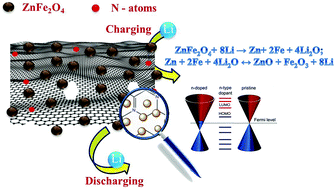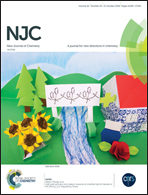N-Doped graphene with anchored ZnFe2O4 nanostructures as an anode for lithium ion batteries with enhanced reversible capacity and cyclic performance†
Abstract
The challenges in developing more efficient lithium ion (Li-ion) batteries as a power source has been the subject of tremendous research due to the increase in demand for high-power unplugged electronics. Unlike commercial anodes, hierarchically decorated ZnFe2O4 on N-doped graphene as an anode exhibits state-of-the-art electrochemical properties. Even after 100 cycles at a current rate of 0.1, 0.2 and 1C, the anode displays high specific capacities of 1859, 982, and 740 mA h g−1, respectively, with a capacity retention close to 100%. N-Doping on the graphene sheet enhances the electrical contact between the particles, which is expected to be the reason for the enhanced areal capacity and cyclic stability of the anode. In addition, the conductive graphene framework prevents surface migration of the nanoparticles and their agglomeration upon cycling, thus creating a buffer space for charge conduction and the transport of Li ions. The N-doped graphene/ZnFe2O4 nanocomposite anode has superior performance than the routinely used pristine anode in Li-ion batteries.



 Please wait while we load your content...
Please wait while we load your content...